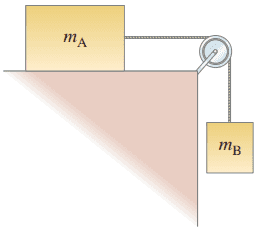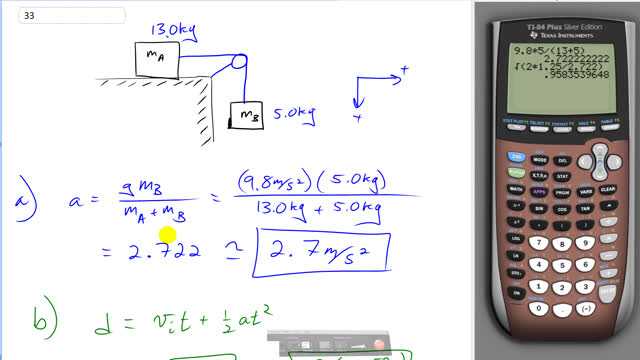
- If and in Fig. 4–53, determine the acceleration of each block.
- If initially is at rest 1.250 m from the edge of the table, how long does it take to reach the edge of the table if the system is allowed to move freely?
- If , how large must be if the acceleration of the system is to be kept at ?


In order to watch this solution you need to have a subscription.
This is Giancoli Answers with Mr. Dychko. Let's use the result we had from question 32 that the acceleration of the system will be g times mass of B divided by the sum of mass A and B. And then we'll substitute in numbers. We have 9.8 meters per second squared times mass A of 5 kilograms divided by 13 kilograms plus 5, gives 2.7 meters per second squared is the acceleration of the system. So, a mass B will able to accelerate down at that rate and mass A will accelerate to the right at that rate. Part B says, supposing mass a is... Where is it? 1.25. 1.25 meters away from the edge, how long will it take before it reaches the edge? So, the initial velocity is zero and we'll solve this equation D equals 1/2 at squared for t by multiplying both sides by 2 over a. And then taking the square root of both sides, and we get the time will be the square root of two times the distance that block A has to travel, 1.25 meters, divided by its acceleration 2.722 meters per second squared, and it'll take 0.96 seconds for it to reach the edge of the table. And the next question is, supposing mass B is 1 kilogram, how much should mass A be so that the acceleration of the system is 1/100 of g. So, the acceleration is this formula here and that has to be g divided by 100 we're told, and the g's will cancel. And then we can also raise both sides to the same exponent. And let's choose exponent negative 1 here so that we get the unknown mA in the numerator, it's not very nice to have the unknown in the denominator. So, we moved it to the numerator by taking the reciprocal of both sides. And that gives mA plus mB over mB equals 100. And then multiply both sides by mB. That gives mA plus mB equals 100 mB. And then subtract mB from both sides. And you get mA is 99 times whatever mB is. Well, mB is 1 kilogram, so, 99 times that, makes mA, needs to be 99 kilograms.